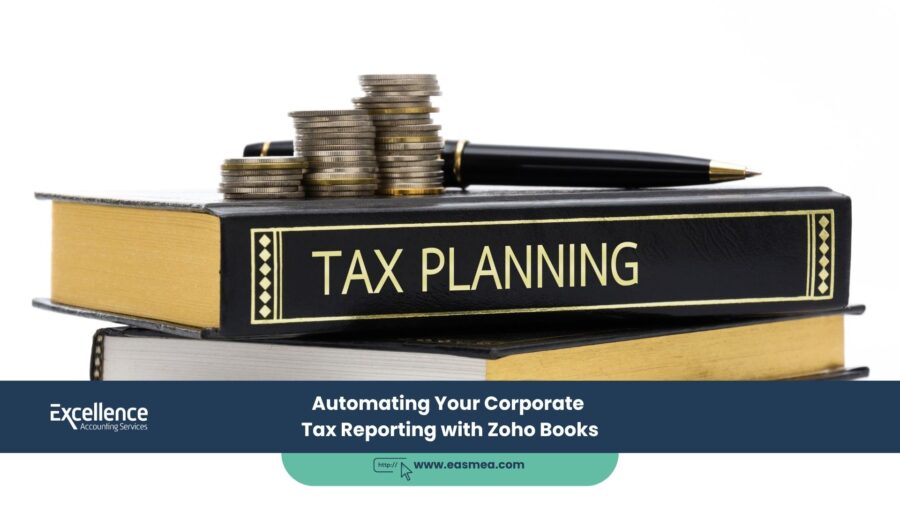Automating Your Corporate Tax Reporting with Zoho Books
The annual Corporate Tax return is the final exam for your company’s financial discipline. It’s the culmination of a year’s worth of transactions, calculations, and record-keeping. For businesses in the UAE relying on manual processes and disjointed spreadsheets, this “exam” can be a frantic, stressful scramble to assemble accurate data. This manual approach is not only inefficient but also fraught with risk. A simple data entry error or a miscalculation can lead to an incorrect tax filing, attracting the scrutiny of the Federal Tax Authority (FTA) and potential penalties.
In the modern tax era, automation is the key to accuracy, efficiency, and peace of mind. The goal of a well-managed business is not just to file a tax return, but to have a system where the tax return is the natural, automated output of its daily operations. This is the power that a cloud accounting platform like Zoho Books brings to UAE businesses. It transforms Corporate Tax reporting from a year-end project into a continuous, automated process.
This guide will explore the practical ways in which Zoho Books automates the key aspects of Corporate Tax reporting. We will cover how it helps build a compliant data foundation, streamlines the generation of essential financial reports, and provides the audit-ready transparency that is crucial for compliance. For any business looking to move beyond manual tax prep, this is your roadmap to a more efficient and accurate future.
Key Takeaways
- Automation Reduces Risk: Automating your accounting and tax reporting process with a tool like Zoho Books significantly reduces the risk of manual errors that can lead to FTA penalties.
- It Starts with Data Integrity: Features like bank feeds and automated expense categorization ensure that the underlying data for your tax return is complete and accurate from the start.
- One-Click Report Generation: Zoho Books generates the core financial reports (P&L, Balance Sheet) required for your tax return with a single click, based on real-time data.
- Compliant Chart of Accounts is Key: A well-structured Chart of Accounts, customized for tax, allows Zoho to automatically segregate different types of income and expenses.
- Audit Trail for Peace of Mind: The system’s automatic audit trail provides a complete history of every transaction, offering the transparency required during an FTA audit.
- Expert Implementation Unlocks Full Potential: To maximize automation, a professional Zoho Books implementation is crucial to correctly configure the system for UAE tax laws.
The Problem with Manual Tax Reporting
Before diving into the solution, it’s important to understand the flaws of the traditional, spreadsheet-based approach:
- Prone to Human Error: Manual data entry is a leading cause of errors in financial records.
- Time-Consuming: Manually compiling a year’s worth of data into a P&L and Balance Sheet can take days or weeks.
- Lack of Real-Time Insight: Data is always outdated, making proactive financial management impossible.
- No Audit Trail: It’s difficult to track changes or verify the source of a number in a spreadsheet, which is a major red flag for auditors.
How Zoho Books Automates the Reporting Process
Zoho Books is designed to be a “single source of truth” for your finances. By centralizing all financial activity, it automates the creation of the reports you need for your Corporate Tax return.
1. Building the Automated Data Foundation
Accurate reports can only come from accurate data. Zoho Books automates the data capture process:
- Bank Feeds: By linking your business bank account, all transactions are automatically imported. This eliminates manual entry and ensures no transaction is missed.
- Expense Management: The mobile app allows you to capture receipts instantly. OCR technology can even read the data from the receipt and auto-populate the expense form.
- Categorization Rules: You can set up rules to automatically categorize recurring transactions from your bank feed (e.g., every DEWA payment is automatically assigned to the “Utilities” expense account).
This ensures that from day one, your financial data is being captured and organized in a structured, tax-compliant way with minimal manual effort.
2. The Power of a Tax-Optimized Chart of Accounts
As detailed in our guide to tracking deductible expenses, the Chart of Accounts is your primary tool for automation. By setting up specific accounts for different types of income and expenses (e.g., “Qualifying Income” for Free Zone companies, or “Client Entertainment” for partially deductible costs), you enable Zoho’s reporting engine to do the heavy lifting.
3. One-Click Generation of Core Financial Reports
The financial statements are the backbone of your Corporate Tax return. With Zoho Books, generating them is effortless.
- Profit and Loss (Income Statement): Go to Reports > Business Overview > Profit and Loss. You can instantly generate this report for your exact financial year. Because you’ve already categorized your transactions correctly throughout the year, this report will automatically show your total revenue and a detailed breakdown of all your expense categories.
- Balance Sheet: Similarly, the Balance Sheet report is always live and up-to-date, reflecting your real-time assets, liabilities, and equity.
These reports provide the primary figures needed to begin your tax calculation, generated in seconds instead of days.
4. Automated Depreciation Schedules
Depreciation is a key deductible expense. The Fixed Asset module in Zoho Books automates this calculation.
- Record your assets in the module.
- Set the depreciation method and useful life.
- Zoho Books will automatically calculate the monthly or annual depreciation and post the journal entries.
This ensures the depreciation expense is automatically and accurately included in your Profit and Loss report, ready for your tax return.
5. The Indispensable Audit Trail
During an FTA audit, you will be asked to justify your numbers. Zoho Books provides an automatic, un-editable audit trail for every single transaction. You can click on any number in any report and drill down to see the original transaction, who created it, when it was created, and any subsequent changes. This level of transparency is impossible to achieve with spreadsheets and provides immense confidence during an audit.
| Manual Process | Automated Zoho Books Process |
|---|---|
| Manually enter hundreds of bank transactions into a spreadsheet. | Transactions are automatically imported via Bank Feeds. |
| Spend days at year-end compiling data to create a P&L. | Generate an accurate, real-time P&L report in one click. |
| Manually calculate depreciation for each asset. | The Fixed Asset module automatically calculates and posts depreciation. |
| Struggle to find the source document for a specific expense. | Drill down from any report directly to the attached source document. |
Unlock Full Automation with Expert Implementation from EAS
Zoho Books is a powerful automation engine, but it needs to be configured correctly to align with UAE tax laws. As certified Zoho Partners and expert tax advisors, Excellence Accounting Services (EAS) ensures your system is optimized for seamless Corporate Tax reporting.
Our Services:
- Tax-Compliant System Setup: We design and implement a Chart of Accounts and system configuration that automates the tracking of different income and expense types for tax purposes.
- Managed Accounting Services: We can manage your day-to-day bookkeeping within Zoho, ensuring ongoing accuracy and compliance.
- Corporate Tax Return Filing: We use the automated, accurate reports from Zoho Books as the foundation for preparing and filing your annual Corporate Tax return, ensuring a smooth and error-free submission.
Frequently Asked Questions (FAQs)
No. Currently, no accounting software can file the Corporate Tax return directly. Zoho Books automates the *preparation* of the financial data and reports that you or your tax agent will use to manually fill out the tax return form on the EmaraTax portal.
Zoho Books calculates your “Accounting Profit.” Your final “Taxable Income” may require specific tax adjustments that are not standard accounting functions (e.g., applying the 50% deduction for client entertainment). The software provides the accurate accounting profit, which is the starting point for these final tax adjustments.
By using the “Reporting Tags” feature, you can tag every revenue transaction as either “Qualifying Income” or “Non-Qualifying Income.” You can then run a Profit and Loss report filtered by these tags. This automatically generates two separate income statements, providing the clear segregation required by the FTA to prove your eligibility for the 0% rate.
Yes. You can migrate your data to Zoho Books. This typically involves importing your opening balances, customer and supplier lists, and Chart of Accounts. An expert implementation partner can manage this process to ensure a smooth transition.
Yes. You can grant user access to your external tax advisor with specific permissions. This is a highly efficient way to collaborate, as it allows them to access the reports and data they need directly, without you having to export and email files.
Yes. Zoho invests heavily in security. Your data is encrypted and stored in secure data centers with multiple backups. Cloud accounting is generally more secure than storing sensitive financial data on a local office computer.
By using Zoho Books, all your financial records, including invoices, bills, and transaction history, are automatically stored in the cloud. You can attach digital copies of source documents to each transaction. This creates a secure, centralized, and permanent archive that fulfills the FTA’s long-term record-keeping requirements.
Yes. Using the “Branches” feature in Zoho Books, you can track the finances of different locations separately. You can then generate consolidated reports for the entire business, which would be used for the single Corporate Tax return, as the tax is levied on the company as a whole.
The Profit and Loss (P&L) report is the most important, as it provides the revenue and expense figures that form the basis of your taxable income calculation. The Balance Sheet is also required to provide a complete picture of the company’s financial position.
Yes. Automation handles the *processing* of data. You still need an expert for the *strategy* and *review*. A tax advisor is crucial for interpreting the law, making the correct tax adjustments to your accounting profit, and ensuring your overall tax strategy is sound. The software is a tool; the expert is the strategist who wields it.
Conclusion: From Manual Burden to Strategic Asset
The requirement to file a Corporate Tax return should not be a source of year-end stress. By embracing automation with a platform like Zoho Books, you can transform your tax reporting process from a manual, error-prone burden into a strategic asset. A system that provides continuous, accurate, and transparent financial data not only ensures compliance but also empowers you with the real-time insights needed to make smarter business decisions throughout the year. In the new tax landscape of the UAE, automation is no longer an option; it’s the foundation of a resilient and well-managed business.
Automate Your Compliance. Focus on Your Growth.
Our certified experts will configure your system for seamless compliance, so you can stop worrying about tax and start focusing on your business.




